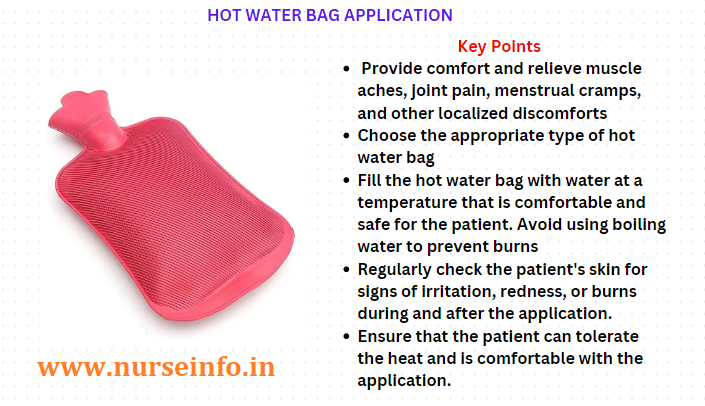Updated 2024
HOT WATER BAG – HOT APPLICATION – Purpose, Preliminary Assessment, Preparation of Patient and Environment, Equipment, Procedure and After Care
Hot water bag is a common method of applying local dry heat. It used as both a therapeutic and a conform measure.
Hot water bag application is defined as process of applying dry heat by means of a rubber bag on specific part of body
Purpose
- To provide comfort and warmth
- To stimulate circulation
- To relieve pain
- To relax muscles
- To promote healing
- To relieve congestion and inflammation
- To relieve bladder distension
Preliminary Assessment
Check
- Doctors order for any specific instructions
- General condition of the patient
- Type of application to be used, duration and frequency of treatment
- Inspect the part for any lesions
- Presence of any contraindications for the application of heat
- Self-care ability to follow instruction
- Articles available in the unit
Preparation of the Patient and Environment
- Explain the procedure to the patient
- Provide privacy, if needed
- Expose only the part that needs treatment
- Place in a comfortable position
- Arrange the articles at the bed side
Equipment
- Hot water bag with cover
- Jugs – 2
- Duster – 1
- Towel – 1
- Vaseline or oil
- Bath thermometer
Procedure
- Wash hands
- Check hot water bag for any leakage
- Check the temperature of water with a bath thermometer
- The temperature should be 105 to 115 degree F for children and 115 to 125 degree F for adults
- Keep the bag on flat surface
- Pour hot water into bag until 2/3rd full
- Expel excess air by permitting water to come to mouth of bag and then close
- Hold bag upside down to check for leakage
- Wipe outside with duster put into flannel cover and apply to part
- Expose only the part that needs treatment and apply it. Apply the hot water bag over the area and cover it with the towel or sheet
- Provide warmth by covering all nontreatment areas with bath blanket or bed covers
- Remove bag after about 20 to 30 minutes
After Care
- Dry the area if, moist the perspiration
- Inspect the part for redness
- Position the patient comfortably on the bed
- Cover the patient with sheets and remove the drapes if any
- Empty the bag and hang upside down
- Replace the articles after cleaning
- Wash hands
- Record the procedure in nurse’s record sheet

General Instructions
- The water should not be hot enough to burn the patient
- The temperature of the water should be between 105 to 115 degree F for children and 115 to 125 degree F for adult
- Air should be expelled out from the hot water bag because air in the bag will interfere with the conduction of heat
- In case of unconscious patient, patient in shock or as infant that hot water bag should be placed outside the blanket covering the patient
- Assess the condition of the patient prior to, during and after the application of the heat, watch for the vital signs
- Maintain the correct temperature for entire duration of the application
- Check the position of hot water bag frequently when the patient is very sick or unconscious
Contraindications
- Open wounds
- Hypertension
- Metabolic disorders
- Impaired kidney, heart and lung functions
- Acute inflammations

NURSING PROCEDURES LIST CLICK HERE
NURSING IMPORTANT QUESTIONS – CLICK HERE
KEY POINTS ON HOT WATER BAG APPLICATION
Hot water bag application, also known as hot water bottle therapy, is a common method of applying heat to relieve pain or discomfort. Here are key points to consider when using a hot water bag:
- Indications:
- Hot water bags are typically used to provide comfort and relieve muscle aches, joint pain, menstrual cramps, and other localized discomforts.
- Inspection:
- Before use, inspect the hot water bag for any signs of damage, leaks, or wear. Ensure that the cap or stopper is secure.
- Type of Hot Water Bag:
- Choose the appropriate type of hot water bag. Some are made of rubber, while others may be made of alternative materials. Follow the manufacturer’s guidelines.
- Temperature Regulation:
- Fill the hot water bag with water at a temperature that is comfortable and safe for the patient. Avoid using boiling water to prevent burns.
- Preventing Burns:
- Wrap the hot water bag in a towel or cloth before applying it to the skin. This helps prevent direct contact and reduces the risk of burns.
- Application Time:
- Follow the recommended application time based on the healthcare provider’s instructions. Prolonged exposure can lead to skin damage.
- Positioning:
- Ensure that the hot water bag is securely placed on the affected area. Avoid placing excessive pressure on the bag to prevent leaks.
- Monitoring:
- Regularly check the patient’s skin for signs of irritation, redness, or burns during and after the application.
- Ensure that the patient can tolerate the heat and is comfortable with the application.
- Patient Education:
- Instruct the patient on the proper use of the hot water bag.
- Advise them to report any discomfort, skin changes, or adverse reactions promptly.
- Storage and Maintenance:
- Store the hot water bag in a cool, dry place when not in use.
- Periodically check for wear and tear, and replace the hot water bag if it shows signs of damage.
- Contraindications:
- Avoid using hot water bags in certain conditions such as acute inflammation, open wounds, or impaired sensation.
- Documentation:
- Record the application details, including the duration, temperature, and the patient’s response, in the patient’s medical record.

